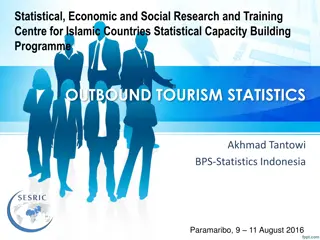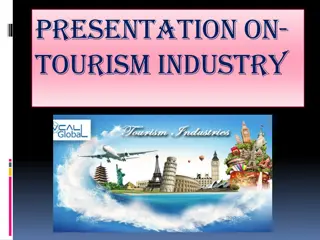Strategic Management in Tourism: Embracing Technological Innovations
"Explore the impact of new technologies on the tourism industry and the strategic management decisions that companies need to consider. From Augmented Reality to Biometrics, discover how technology is reshaping the future of tourism experiences and competitiveness."
Download Presentation

Please find below an Image/Link to download the presentation.
The content on the website is provided AS IS for your information and personal use only. It may not be sold, licensed, or shared on other websites without obtaining consent from the author.If you encounter any issues during the download, it is possible that the publisher has removed the file from their server.
You are allowed to download the files provided on this website for personal or commercial use, subject to the condition that they are used lawfully. All files are the property of their respective owners.
The content on the website is provided AS IS for your information and personal use only. It may not be sold, licensed, or shared on other websites without obtaining consent from the author.
E N D
Presentation Transcript
3rd Edition Strategic Management In Tourism Edited by LUIZ MOUTINHO AND ALFONSO VARGAS S NCHEZ
CHAPTER 10 TECHNOLOGY MANAGEMENT IN TOURISM LUIZ MOUTINHO, ALFONSO VARGAS-S NCHEZ AND MAR A MORAL-MORAL
LEARNING OBJECTIVES Explaining the main technological innovations nowadays and their influence on tourism. Being aware of some experiences of technological innovation and its implementation in the tourism industry. Emphasizing the opportunities and benefits of incorporating new technological advances in tourism.
1 INTRODUCTION: TECHNOLOGICAL EVOLUTION AND STRATEGIC MANAGEMENT New technologies are transforming (or reinventing) the travel experience, with deep strategic implications for tourism companies and the whole industry (new business models, etc.). Technology and innovation are intimately bound, and innovation is undoubtedly at the heart of the discourse on strategy and competitiveness. Tourism companies must rethink what they do as a result of tech changes. Every aspect of tourist interaction must be scrutinized and, in particular, new technological solutions are being very useful for this analysis and the corresponding improvement.
1 INTRODUCTION: TECHNOLOGICAL EVOLUTION AND STRATEGIC MANAGEMENT The future of tourism is being significantly impacted by a bunch of new technologies in permanent evolution: Augmented Reality; Touchwalls; eMotion Walls; Sensor Tiles; Natural Language Processing; Real-time translation; Green technologies; Usage of 3D; Human-Computer interaction; Remote Control Tourist; Biometrics; Voice prints; Voice recognition; Facial coding; Communicating objects; Interactive electronic papers; Radio Frequency Identification; Virtual Reality + Augmented Reality = Mixed Reality; Near Field Communication; Fingertip; Eye scan; DNA scan; QR codes; etc.
2 TECHNOLOGIES AND INNOVATIONS: INFLUENCING TOURISM Having experienced the evolution from the World Wide Web in the 1990s to the mobile Internet in the beginning of the 21st century, we are heading towards the Internet of Things, which is likely the tech phenomenon with a deeper influence in the years to come. However, the Internet of Things is already moving into a new level: the Internet of Emotions. Internet has started being emotional. Tourists could be segmented based on their emotions, helping to design and offer personalized experiences (and advertisements) according to people s moods.
2 TECHNOLOGIES AND INNOVATIONS: INFLUENCING TOURISM Smart tourism A Smart Tourist Destination is based on an extensive use of cutting edge technologies in order to create an advanced digital space able to improve the whole management of the destination. It is built on the values of innovation and sustainability, working to improve the tourist s experience and enhance the quality of life of local communities (residents). Spain has been the pioneer country in establishing the requirements of a management system for Smart Tourist Destinations through the norm UNE 178501:2016.
3 TECHNOLOGY SOLUTIONS FOR TOURISM: SOME EXPERIENCES The future of tourism is determined by a range of new technologies in permanent evolution, listed in section 1. New technological solutions are intended to improve the experience of tourists and increase their level of satisfaction. In addition, they can serve some tourist segments, such as people with disabilities and reduced mobility. In the near future, our daily lives (also as tourists) will be much more technology dependent. In this section a number of examples are offered, related to various types of technologies.
4 CONCLUSIONS New technologies will be increasingly used to drastically increase efficiency, reduce costs, personalize the customer experience and improve service. Nowadays, the greatest efforts are being made in the areas of machine learning, natural language processing, voice recognition and chatbots. All of them are related and Artificial Intelligence can play a key role in all. Within the current hyper-dynamic environment, experimentation is the new planning. Any organization has to be transformed into an engine of possibilities, into an evolving portfolio of strategic experiments.























